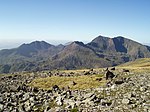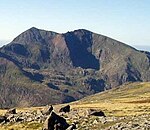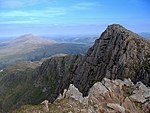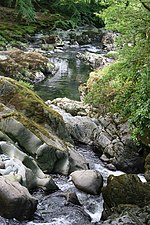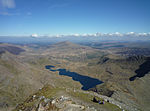Snowdon () or Yr Wyddfa (pronounced [ər ˈʊɨ̞̯ðva] (listen)) is the highest mountain in Wales, at an elevation of 1,085 metres (3,560 ft) above sea level, and the highest point in the British Isles outside the Scottish Highlands. It is located in Snowdonia National Park (Parc Cenedlaethol Eryri) in Gwynedd (historic county of Caernarfonshire).
It is the busiest mountain in the United Kingdom and the third most visited attraction in Wales; in 2019 it was visited by 590,984 walkers, with an additional 140,000 people taking the train. It is designated as a national nature reserve for its rare flora and fauna.
The rocks that form Snowdon were produced by volcanoes in the Ordovician period, and the massif has been extensively sculpted by glaciation, forming the pyramidal peak of Snowdon and the arêtes of Crib Goch and Y Lliwedd. The cliff faces on Snowdon, including Clogwyn Du'r Arddu, are significant for rock climbing, and the mountain was used by Edmund Hillary in training for the 1953 ascent of Mount Everest.
The summit can be reached by a number of paths (there are six main paths) and by the Snowdon Mountain Railway, a rack railway opened in 1896 which carries passengers the 4+3⁄4 miles (7.6 kilometres) from Llanberis to the Summit station. The summit building, called Hafod Eryri, houses a cafe and is open only when the railway is operating; it opened in 2009 to replace one built in the 1930s. The railway generally operates from March to the end of October, with trains running to the summit station from May. The daily running schedule depends on weather and customer demand.
Snowdon is one of three mountains climbed as part of the National Three Peaks Challenge.

